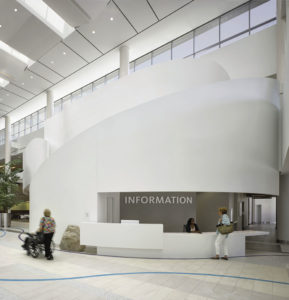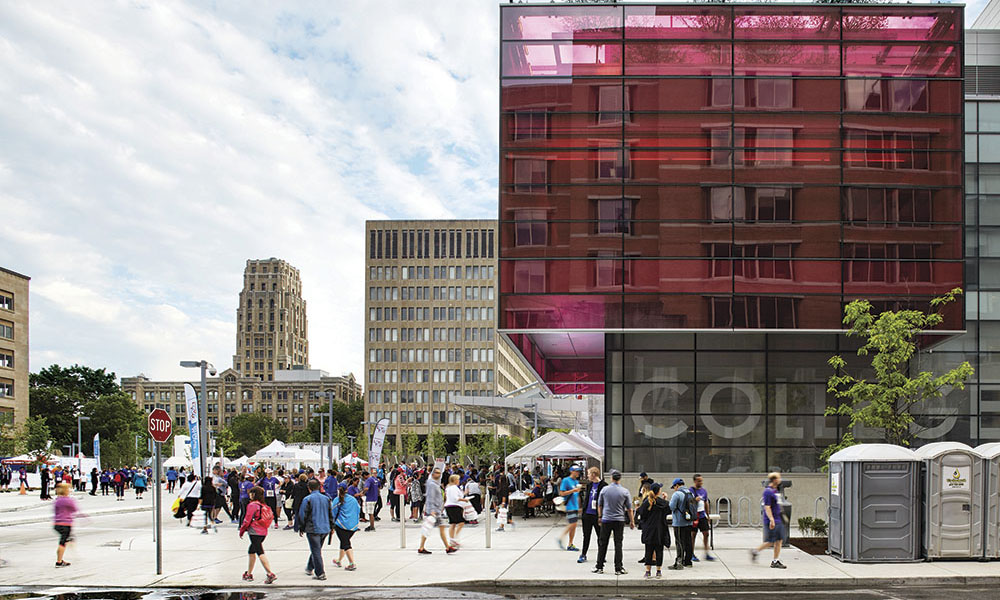Women’s College Hospital, designed by Perkins Eastman Black/IBI Group Architects, in Toronto, is the recipient of the 2016 Generative Space Award, presented at the Health Facilities Symposium and Exhibition. Women’s is the largest academic ambulatory care center and research institute in Canada, dedicated to improving the lives of women and their families.
The Generative Space Award is an initiative of The Caritas Project. Its judging criteria provides a two-part diagram, where “The Status Quo” portion of this diagram illustrates a one-sided relationship of patient to caregiver contrasted against an inspirational opportunity to cultivate “The New Paradigm.” The “15+ arrows,” in this New Paradigm model, stimulates creative thinking toward achieving personal connections with meaningful design solutions, as each user touch point is considered throughout the planning and design process.
For Women’s, the principles that the TCP New Paradigm model advocated were abstracted into a customized diagram reflecting its bold and unique mission. Just as The New Paradigm diagram illustrates, the organization is positioned in the center of the diagram — but in the case of Women’s, there are three circles representing its translational platform where research, education and practice inter-relate. The community takes an enveloping position, in this unique diagram, as it surrounds the organization, creating a dynamic wheel.
For this organization, it was a meaningful exercise to create this project-specific diagram, which reinforced the aspired connections as the project came to fruition. In the online version of the Women’s College Hospital Generative Space Award, more than 25 personal story vignettes illustrate connections of actual relationships supported by hospital operations and the physical design (see: www.aplacetoflourish.net ).
Themes abstracted from research that asked stakeholder groups and 1,000 women about their healthcare needs clarified intentions in the architecture and design, as described below. These themes surfaced as distinct well-being ingredients adapted to support organizational and physical planning throughout the facility — enabling the creation of meaningful “places to flourish.” Satisfaction surveys confirm appreciation and recognition of the design and embedded improvements at Women’s by substantiating a rise in the number of patients served, along with higher staff retention and recruitment.
Theme One: Make my first impression welcoming
Creating this expectation of “welcome” at the initial approach to the site begins the arrival process. Identifying the hospital with a symbolic fuchsia cantilevered cube at the leading corner of the building forecasts an unequivocal “heart” within — a bold decision that the hospital embraced. A large canopy provides protection at the main entrance where detailed gray tones mark the drop-off area, as a pleasant alternative to objectionable — more conventional — painted yellow lines.
A friendly face offers a welcoming arrival, once inside the front door — providing volunteers with an important role. The light and nature-filled atrium is generous with choices in seating areas, along with food offerings to satisfy varied cultural preferences. Curving forms create a non-hospital sensibility and wrap social balconies leading to conference functions one floor up.
Theme Two: The context of women’s lives
“Respect for time” was a major concern that women identified. To increase throughput in unhurried but intentional patient experiences, clarity was achieved by locating each clinical pod immediately off waiting rooms. This decreased travel distances and reduced operational challenges, resulting in a reduction of average wait times up to 20 minutes. Larger client/patient meeting spaces supplement this throughput strategy, enabling patient scheduling with multiple caregivers at one time.
Registration stations near elevator lobbies, generic exam rooms, inclusion of specialty diagnostics within departments and intuitive wayfinding provide clarity of experience. An important amenity — complimentary childcare during appointments — relieves pressures of time, money and anxiety for a stressed parent.
Children have their own table surrounding a tall bubble tube feature in the atrium — and a large white community table is becoming a known destination, as a regular place to meet. A food zone provides a range of cuisine, appealing to different cultures and has become an attraction in the surrounding community as a lunch destination.

Theme Three: Treat me as a whole person
To provide the best holistic care possible, women are supported by the translational platform. Teaching spaces are situated within each clinical pod, enabling timely onsite research innovation to be transferred through learning and education directly to patients and clinical practices.
To reinforce this knowledge sharing, a destination venue was created as a designated conference center off the atrium. This resource is as much an internal hub for knowledge sharing as it is for community teaching and involvement. Surprisingly, it has become a revenue producer, as a consequence of its design and presence becoming known throughout the healthcare industry.
A mental health program includes art and music therapy rooms. A transparent staircase begins in the main atrium and connects to clinical floors, addressing women’s concerns about their safety and anxiety of being in enclosed elevators. Within the main atrium is a spiritual room with a labyrinth enhanced by an absorbing oversized imprint of textured leaves — all to offer experiential and holistic considerations toward treating the whole person.
Theme Four: The Great Woman’s Home
Women requested a place that is welcoming and bright — focused upon wellness, not illness. They wanted a place that inspires health, healing and community.
The atrium provides a light- and nature-filled space, with opportunities for choice and inclusivity in spaces and seating, without deference to any one style — responding to the preferences declared by over 1,000 women from all walks of life. The public spaces throughout Women’s address the five potential arrows in The New Paradigm diagram — including the Patient/Consumer, Family/Companion, Staff, Community and Visitor.
Feminine artifacts and culturally empowering art are integrated throughout the facility. Participatory cultural projects — by all stakeholders — have been initiated on each landing of the atrium stairway. One such project is an interpretive tapestry, reminiscent of the age-old social art of the quilting bee. Additional continuing participatory projects include: Crossroads (a refugee clinic), nutrition and famous market places, a history of dolls and patient art.
The stakeholder research expressed a noted appreciation for curving forms. This sensibility is reflected in the atrium with folding planes, and in the auditorium with its womb-like enclosure. Behind the defining arch in the auditorium, an installation created from wire mesh in ribbon forms provides an inspirational backdrop, while also stimulating the impulse to create additional cultural artifacts throughout the facility.
Women’s fully embraced its redevelopment opportunity to serve women, to contribute to urban placemaking and to being a community sanctuary. Branding the cantilevered pink structure as an icon helps spread its messages. In accomplishing this, it has become evident that helping women and girls affects not only their immediate families, it also impacts their communities and, by ripples, the world we live in — establishing a truly generative halo effect.





